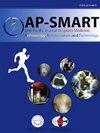关节镜内外“双针缝合”技术治疗外侧半月板前角撕裂
IF 1.4
Q3 ORTHOPEDICS
Asia-Pacific Journal of Sport Medicine Arthroscopy Rehabilitation and Technology
Pub Date : 2025-09-06
DOI:10.1016/j.asmart.2025.08.003
引用次数: 0
摘要
背景外向内缝合技术被认为是治疗外侧半月板前角撕裂的一种实用方法。传统的由外而内的技术通常需要腰椎穿刺针或专门的器械(半月板修补器II)。在这项研究中,我们采用了一种相对新颖实用的由外而内的“双针缝合”技术来修复半月板前角。这种方法简单,不需要任何专门的仪器。目的报道关节镜下由外向内“双针缝合”技术修复LM前角撕裂并评价其治疗效果,为LM前角损伤的临床治疗提供依据。方法2019年3月至2023年8月,在我院骨科中心采用“双针缝合”技术治疗21例LM前角撕裂。术前、术后记录手术次数、撕裂分类、Lysholm评分、IKDC评分、Tegner评分,并采用配对t检验分析功能评分。此外,采用Barrett标准评估半月板的愈合情况。结果“两针缝合”法仅使用20 mL空心针进行缝合,两根针分别从半月板上、下表面进入关节腔。第一针将缝合线穿过第二针预设的缝合环,然后将缝合线在关节囊外打结。本研究随访时间12.38±1.83个月,手术时间32.95±11.89 min。与术前相比,最终随访时Lysholm、IKDC和Tegner评分均有显著改善(p < 0.05)。按照Barrett标准,半月板临床治愈率为90.48%。此外,未观察到并发症或危险。结论关节镜下“双针缝合”治疗LM前角撕裂术简单、快速、安全,临床治愈率高。该技术对LM前角损伤的临床治疗具有重要的参考价值。本文章由计算机程序翻译,如有差异,请以英文原文为准。
Arthroscopic outside-in “two-needle suture” technique for anterior horn tears of the lateral meniscus
Background
The outside-in suture technique is regarded as a practical method for treating anterior horn tears of the lateral meniscus (LM). The conventional outside-in technique often requires a lumbar puncture needle or specialized instruments (Meniscus Mender II). In this study, we employed a relatively novel and practical outside-in “two-needle suture” technique for anterior horn of meniscus repair. This method is simple and does not require any specialized instruments.
Objective
The aim of this study is to report the use of the arthroscopic outside-in “two-needle suture” technique for repairing anterior horn tears of the LM and to evaluate its therapeutic effect to provide a foundation for the clinical management of anterior horn injuries of the LM.
Methods
From March 2019 to August 2023, 21 patients with anterior horn tears of the LM were treated at our orthopedic center using the “two-needle suture” technique. We recorded the operation times, tear classifications, Lysholm scores, IKDC scores, and Tegner scores preoperatively and postoperatively and analyzed the functional scores using paired t tests. Additionally, the Barrett criterion was employed to evaluate the healing status of the meniscus.
Results
In the “two-needle suture” method, only 20 mL hollow needles are used for suturing, with two needles advanced into the joint cavity from the superior and inferior surfaces of the meniscus. The first needle pulled the suture thread through the preset suture loop of the second needle, and then the suture thread was knotted outside the joint capsule. In our study, the follow-up period was 12.38 ± 1.83 months, and the operative time was 32.95 ± 11.89 min. Compared with the preoperative values, significant improvements in the Lysholm, IKDC, and Tegner scores were observed at the final follow-up (p < 0.05). According to the Barrett criterion, the clinical healing rate of the meniscus was 90.48 %. In addition, no complications or risks were observed.
Conclusion
The arthroscopic “two-needle suture” technique for anterior horn tears of the LM was simple, fast and safe, with a high rate of clinical healing. This technique is useful and a valuable reference for the clinical management of anterior horn injuries of the LM.
求助全文
通过发布文献求助,成功后即可免费获取论文全文。
去求助
来源期刊
CiteScore
3.80
自引率
0.00%
发文量
21
审稿时长
98 days
期刊介绍:
The Asia-Pacific Journal of Sports Medicine, Arthroscopy, Rehabilitation and Technology (AP-SMART) is the official peer-reviewed, open access journal of the Asia-Pacific Knee, Arthroscopy and Sports Medicine Society (APKASS) and the Japanese Orthopaedic Society of Knee, Arthroscopy and Sports Medicine (JOSKAS). It is published quarterly, in January, April, July and October, by Elsevier. The mission of AP-SMART is to inspire clinicians, practitioners, scientists and engineers to work towards a common goal to improve quality of life in the international community. The Journal publishes original research, reviews, editorials, perspectives, and letters to the Editor. Multidisciplinary research with collaboration amongst clinicians and scientists from different disciplines will be the trend in the coming decades. AP-SMART provides a platform for the exchange of new clinical and scientific information in the most precise and expeditious way to achieve timely dissemination of information and cross-fertilization of ideas.

 求助内容:
求助内容: 应助结果提醒方式:
应助结果提醒方式:


